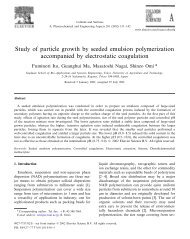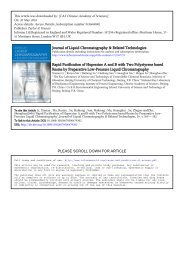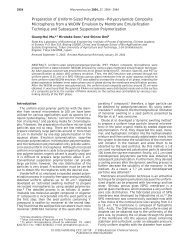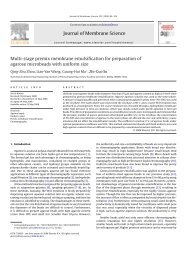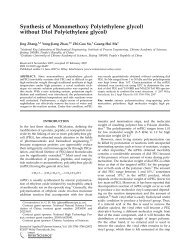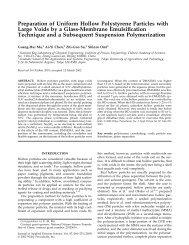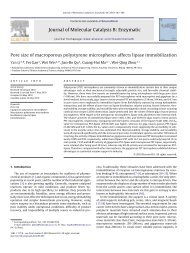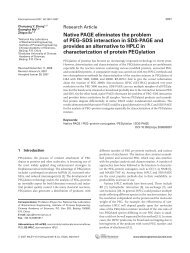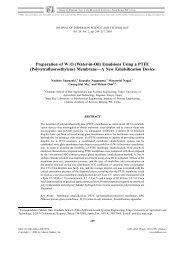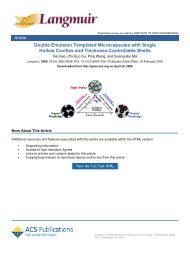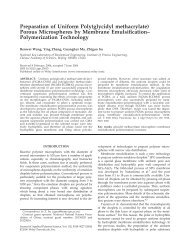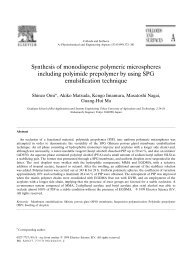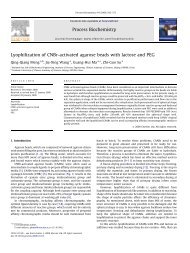Apoferritin–CeO2 nano-truffle that has excellent artificial redox ...
Apoferritin–CeO2 nano-truffle that has excellent artificial redox ...
Apoferritin–CeO2 nano-truffle that has excellent artificial redox ...
You also want an ePaper? Increase the reach of your titles
YUMPU automatically turns print PDFs into web optimized ePapers that Google loves.
Downloaded by Institute of Process Engineering, Chinese Academy of Sciences on 23 May 2012<br />
Published on 01 December 2011 on http://pubs.rsc.org | doi:10.1039/C1CC15815E<br />
Fig. 3 (a) Scavenging of ROS by AFt–CeO2 and <strong>nano</strong>-CeO2 in<br />
HepG2 cells. (b) Representative CLSM images of H 2O 2-treated<br />
HepG2 cells after staining with DCFH-DA. From left to right:<br />
control, cells preincubated with <strong>nano</strong>-CeO 2 (25 mM) and AFt–CeO 2<br />
(25 mM). All the scale bars represent 10 mm.<br />
Fig. 4 (a) Quantification of AFt–CeO 2 and <strong>nano</strong>-CeO 2 internalized<br />
by HepG2 cells. (b–e) Representative CLSM and TEM images of<br />
HepG2 cells with <strong>nano</strong>-CeO 2 (b, d) or AFt–CeO 2 (c, e) internalized. In<br />
CLSM images (b) and (c), the bright spots in the cytoplasm around the<br />
nuclei are the internalized <strong>nano</strong>-CeO 2 (b) or AFt–CeO 2 (c) particles.<br />
(f) TEM image showing the typical macropinocytosis movement for<br />
<strong>nano</strong>-CeO 2 particles to enter HepG2 cells. (g and h) Schematic<br />
illustration of the macropinocytosis for <strong>nano</strong>-CeO2 and the clathrinmediated<br />
endocytosis for AFt–CeO 2. The scale bars in (b) and (c)<br />
represent 10 mm, while those in (d–f) represent 500 nm.<br />
AFt–CeO 2 (Fig. S5, ESIw). How did cells adapt to the AFt–CeO 2<br />
with a high internalized amount and a low cytotoxicity? We<br />
speculated <strong>that</strong> this distinct feature of AFt–CeO2 was partially<br />
attributed to the apoferritin corona, which could potentially<br />
promote the cellular internalization process mediated via specific<br />
ferritin receptors and prevent the adverse interactions between<br />
the <strong>nano</strong>-CeO 2 and biomolecules in the cytoplasm. 18 Further<br />
study (Fig. S6, ESIw) also suggested <strong>that</strong> the internalization of<br />
AFt–CeO 2 was primarily regulated by clathrin-mediated endocytosis<br />
(Fig. 4h), while the internalization of the <strong>nano</strong>-CeO 2 was<br />
a macropinocytosis process (Fig. 4f and g).<br />
In conclusion, we have demonstrated a strategy, combining<br />
cage proteins with a novel synthetic <strong>nano</strong>-material, to construct a<br />
novel <strong>nano</strong>-complex (AFt–CeO2) <strong>that</strong> <strong>has</strong> proven to be by far the<br />
most active <strong>artificial</strong> <strong>redox</strong> enzyme with mimetic SOD activity.<br />
The modification of the surface of <strong>nano</strong>-CeO2 <strong>has</strong> changed the<br />
intrinsic properties of individual building blocks, conferring a<br />
superb <strong>redox</strong> activity to the AFt–CeO 2. In addition, the cage<br />
proteins carry their biological identities to the AFt–CeO 2 to<br />
initiate an endocytosis process and improve its biocompatibility.<br />
This is a step-forward for the rational design/construction of<br />
<strong>artificial</strong> enzymes with designated functions, which have the<br />
potential to treat incurable diseases like some types of amyotrophic<br />
lateral sclerosis due to the failure of defense against ROS.<br />
Acknowledgements. This work received financial support<br />
from the Natural Science Foundation of China (20603036,<br />
21073004). The authors gratefully thank Miss Hua Yue and<br />
Mr. Zhanguo Yue for their help.<br />
Notes and references<br />
View Online<br />
y All the concentrations of AFt–CeO2 mentioned in this study are the<br />
concentrations of Ce, unless otherwise stated.<br />
1 J. Nordberg and E. S. J. Arnér, Free Radical Biol. Med., 2001, 31,<br />
1287–1312.<br />
2 J. M. Mate´s, Toxicology, 2000, 153, 83–104.<br />
3 M. Kajita, K. Hikosaka, M. Iitsuka, A. Kanayama, N. Toshima<br />
and Y. Miyamoto, Free Radical Res., 2007, 41, 615–626.<br />
4 A. S. Karakoti, S. Singh, A. Kumar, M. Malinska, S. Kuchibhatla,<br />
K. Wozniak, W. T. Self and S. Seal, J. Am. Chem. Soc., 2009, 131,<br />
14144–14145.<br />
5 C. Korsvik, S. Patil, S. Seal and W. T. Self, Chem. Commun., 2007,<br />
1056–1058.<br />
6 A. S. Karakoti, N. A. Monteiro-Riviere, R. Aggarwal, J. P. Davis,<br />
R. J. Narayan, W. T. Self, J. McGinnis and S. Seal, JOM, 2008, 60,<br />
33–37.<br />
7 E. G. Heckert, A. S. Karakoti, S. Seal and W. T. Self, Biomaterials,<br />
2008, 29, 2705–2709.<br />
8 B. Hennequin, L. Turyanska, T. Ben, A. M. Beltra´n, S. I. Molina,<br />
M. Li, S. Mann, A. Patanè and N. R. Thomas, Adv. Mater., 2008,<br />
20, 3592–3596.<br />
9 E. Valero, S. Tambalo, P. Marzola, M. Ortega-Mun˜ oz, F. J.<br />
Lo´pez-Jaramillo, F. Santoyo-González, J. D. López, J. J. Delgado,<br />
J. J. Calvino, R. Cuesta, J. M. Domínguez-Vera and N. Ga´lvez,<br />
J. Am. Chem. Soc., 2011, 133, 4889–4895.<br />
10 L. B. Zhang, L. Laug, W. Mu¨nchgesang, E. Pippel, U. Go¨sele,<br />
M. Brandsch and M. Knez, Nano Lett., 2010, 10, 219–223.<br />
11 F. Esch, S. Fabris, L. Zhou, T. Montini, C. Africh, P. Fornasiero,<br />
G. Comelli and R. Rosei, Science, 2005, 309, 752–755.<br />
12 L. J. Wu, H. J. Wiesmann, A. R. Moodenbaugh, R. F. Klie, Y. M.<br />
Zhu, D. O. Welch and M. Suenaga, Phys. Rev. B, 2004, 69, 9.<br />
13 M. T. F. Telling and S. H. Kilcoyne, Phys. B, 2006, 374–375, 451–455.<br />
14 F. Bou-Abdallah, Biochim. Biophys. Acta, Gen. Subj., 2010, 1800,<br />
719–731.<br />
15 P. Dutta, S. Pal, M. S. Seehra, Y. Shi, E. M. Eyring and<br />
R. D. Ernst, Chem. Mater., 2006, 18, 5144–5146.<br />
16 E. Mamontov, T. Egami, R. Brezny, M. Koranne and S. Tyagi,<br />
J. Phys. Chem. B, 2000, 104, 11110–11116.<br />
17 C. P. Lebel, H. Ischiropoulos and S. C. Bondy, Chem. Res.<br />
Toxicol., 1992, 5, 227–231.<br />
18 X. Y. Liu, W. Wei, C. L. Wang, H. Yue, D. Ma, C. Zhu, G. H. Ma<br />
and Y. G. Du, J. Mater. Chem., 2011, 21, 7105–7110.<br />
This journal is c The Royal Society of Chemistry 2012 Chem. Commun., 2012, 48, 3155–3157 3157




